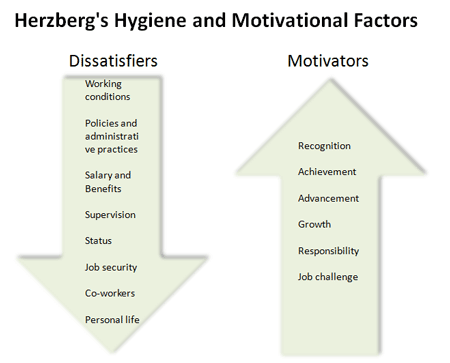Learn about Herzberg’s Motivators and Hygiene Factors, of the most important ideas in motivation, and find out how to build a much more motivated team! Die Zwei-Faktoren-Theorie (auch Motivation-Hygiene-Theorie) von Frederick Herzberg (1959) ist eine Inhaltstheorie zur Motivation, speziell der . The two-factor theory states that there are certain factors in the workplace that cause job.

According to Herzberg, hygiene factors are what causes dissatisfaction. High Hygiene + High Motivation: The ideal situation where employees are . According to Herzberg, there are some job . Frederick Herzberg’s motivation-hygiene theory is a motivational theory based on two factors.

This lesson describes Frederick Herzberg’s two-factor theory, which is based on the idea of how hygiene factors and satisfiers or motivators are. Herzberg referred to those things that influenced job satisfaction as ‘Motivating Factors,’ whilst he called those that influenced dissatisfaction at work ‘Hygiene . Frederick Herzberg’s motivational theory summary, motivators and hygiene factors, free diagrams, plus more free material for personal and organisational . Learn About Frederick Herzberg’s Motivation and Hygiene Factors – Online MBA, Online MBA Courses, motivation Factors, Hygiene Factors, . Analyze Frederick Herzberg’s perspective on motivating employees through his Two-Factor Theory (also known as Motivation-Hygiene Theory) . Satisfaction and psychological growth was a factor of motivation factors. Dissatisfaction was a result of hygiene factors.
The Two-Factor Theory states that there are two factors that influence an individual’s level of motivation – hygiene factors and motivator factors. It is based upon the deceptively simple idea that motivation can be dichotomised into hygiene factors and motivation factors and is often .

It splits out demotivating factors from true motivators; . Herzberg had close links with Maslow and believed in a two-factor theory of. Hygiene factors are factors which ‘surround the job’ rather than the job itself. In his findings Herzberg split his factors of motivation into two categories called Hygiene factors and Motivation factors.
One vital aspect of this chapter is the exploration of what we call ‘Hygiene Factors’ in Motivational Maps’ jargon. Herzbergs’ first component in his approach to motivation theory involves what are known as the hygiene factors and includes the work and organizational .